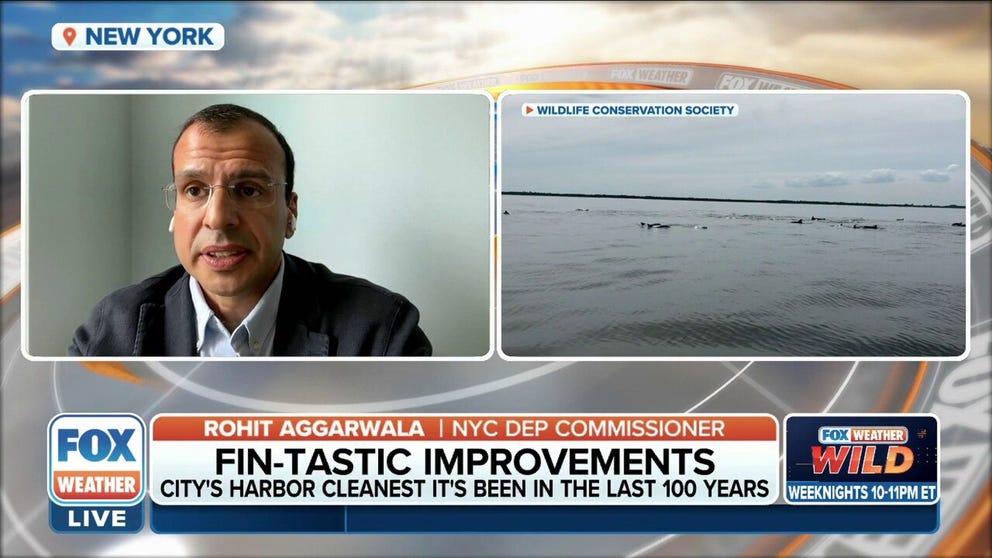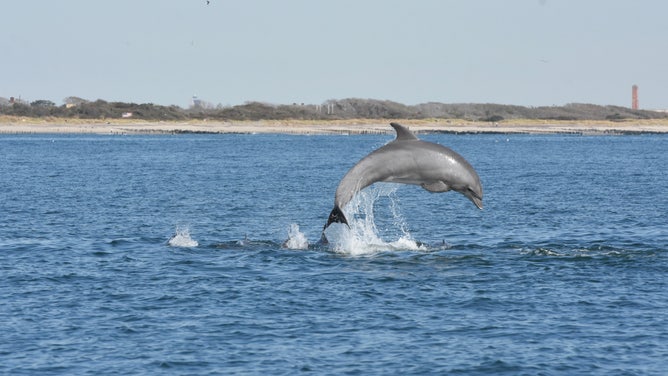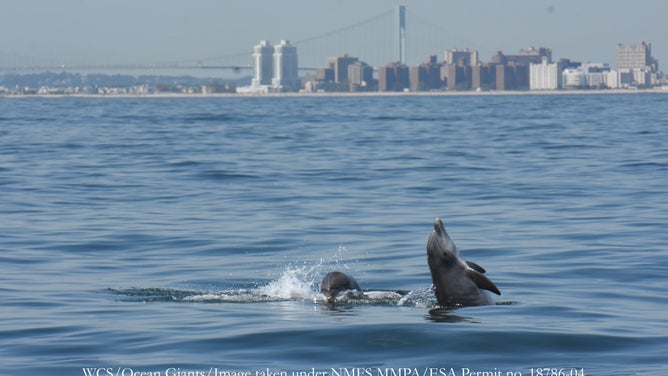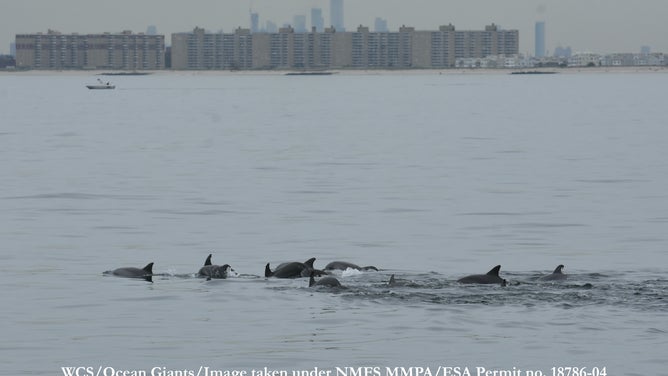Restoring Hudson River ecosystems is essential to continue dolphin and whale sightings
Rain runoff leads to poor water quality and extreme storms from climate change are impacting the Hudson on a larger scale, Riverkeeper scientist says
Dolphins spotted in NYC waterways, cleanest water has been in years
Rohit Aggarwala, NYC DEP Commissioner, says the city's harbor is the cleanest it's been in the last 100 years.
Cleanup efforts in the Hudson River over the past 50 years have led to water quality improvements allowing for better swimming conditions, whale watching and more dolphin encounters; however, environmental groups say there is still more work to be done to enable all marine life in the estuary to thrive.
For the past 14 years, the nonprofit Riverkeeper has worked with volunteers and partners, including Columbia Climate School's Lamont-Doherty Earth Observatory, to take samples of the Hudson across a 150-mile span providing data on water quality, including whether it's safe to swim in based on the Environmental Protection Agency guidelines.
Riverkeeper co-director of science and patrol Dan Shapley is among those out on the patrol boat collecting samples from the New York Harbor to where the estuary connects with the ocean at Troy.
HOW TO WATCH FOX WEATHER ON TV
Where and when the river is safe for swimming depends on a few factors, but one of the biggest is rainfall or storm runoff. Across the 74 locations where samples are taken, Shapley said the data doesn't show a lot of positive or negative trends. Most changes they see are from the weather.
"So if we have a really rainy year, we have really poor water quality more consistently. If we have a dry year, we have better water quality," Shapley said. "It's important to understand that, because not only does it mean for an individual choosing when to go out to swim, think about was there a thunderstorm last night, that's going to influence the water quality that's important. But more also important is realizing that these extreme storms we're getting from climate change, these very large, extreme events, those are having water quality impacts on a vastly larger scale."
Shapley said after several inches of rain, Riverkeeper researchers have seen locations in the Hudson River go from swimmable water quality to unsafe. What's also alarming to those that monitor the Hudson is the increasing frequency of weather events from leftover tropical cyclones or bursts of heavy rain.
"We're just getting them under lots of weather patterns that we didn't always in the past," Shapley said. "Those definitely cause the water quality to degrade."
Dolphin and whale watching delights, but what about the fishes?
The Hudson is one of the most abundant estuaries on the East Coast. Fish including shad, herring, striped bass and sturgeon, spend most of their life in the Atlantic and come into the Hudson to spawn.
"It's this engine of life, not only for the river but for the ocean ecosystem," Shapley said.
That circle of life also applies to the larger marine mammals.
KELP IS ON THE WAY: UNIVERSITY PARTNERS WITH NEW YORK OYSTER FARMERS TO REDUCE OCEAN ACIDIFICATION
"If you're out on a whale watching tour and you see, in the shadow of the New York City skyline, a whale tail, you know, that is in part built on the Hudson River as that engine of life producing those small fish that are the food for the whale."
While seeing dolphins and going whale watching with Gotham Whale is a sign of improvement, other marine life continue to be impacted by pollution in the river.
"Our fish are unfortunately in a much more precarious position, and we have to take a number of actions to see their populations return to abundance and return to a point, ultimately, one day where the Hudson can be a food source again for this region," Shapley explains.
Commercial fisheries for shad, stripe and sturgeon closed in the 1990s and early 2000s because the populations plummeted.
Atlantic sturgeon became a federally recognized endangered species in 2012 when they were part of the commercial fishery industry just a few decades ago. Sturgeon have been around since the age of the dinosaurs and can grow as long at 12 feet, weighing more than 200 pounds.
"Yet they need these small areas in the Hudson River to sustain their population coast-wide today," Shapley said of sturgeon. "So it's really … often very small parts of the Hudson that are critical habitat for species that have, you know, these long lineages and these connections to the ocean ecosystem."
According to Shapley, habitat loss, overfishing and invasive species decimated the populations.
US COASTS COULD SEE CENTURY’S-WORTH OF SEA-LEVEL RISE IN 30 YEARS, NOAA REPORT SAYS
Hudson River is the cleanest in 100 years but still has a long way to go in restoring ecosystems. Shapley said the 1972 Clean Water Act provided the initial funding and federal support to invest in sewage infrastructure and a water treatment plant. In recent years improvements have been mainly driven by local and state efforts.
New York Department of Environmental Protection Commissioner Rohit Aggarwala said the state had invested $50 billion into improving wastewater treatment plants over the past 35 years.
About 150 years ago, the New York Harbor was a haven for wildlife, Aggarwala said.
The next phase of cleaning the Hudson would require replacing old leaking pipes, separating stormwater and sewage pipes, and upgrading water treatment systems as they age.
"In contrast to the water quality improvements where we've seen, you know, steady increase improvements in water quality over 50 years to a point where now we're at a plateau, and we need to push into the next era of improvements," Shapley said.
How to help protect the Hudson
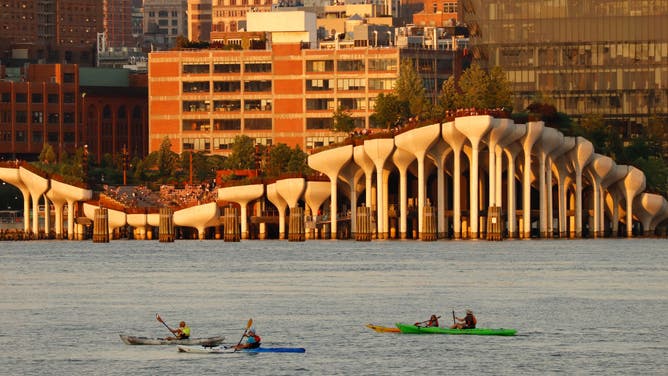
People paddle their kayaks in the Hudson River in front of Little Island as the sun sets in New York City on June 20, 2022, as seen from Hoboken, New Jersey. (Photo by Gary Hershorn/Getty Images)
(Getty Images)
Riverkeeper is hopeful New York Gov. Kathy Hochul will sign new legislation that would benefit streams that run into the Hudson by protecting the natural trees that grow around them.
"That helps to protect the floodplains, allows for the water to go someplace other than rushing through communities and rushing out with pollution into the river," Shapley said. "It's that that kind of watershed approach is really important."
Shapley said contacting elected officials and ensuring the Hudson is a priority is one way anyone can help with efforts to protect the river and its ecosystems.
It's also vital for people to think about what they are putting down the drain or flushing in the toilet.
CLICK HERE TO GET THE FOX WEATHER UPDATE PODCAST
Aggarwala said people should not dump paint or grease down the sink because it can be bad for water treatment plants. One of the biggest culprits is disposable wipes.
"Sometimes they say they're flushable, but they're really not," Aggarwala said. "Whenever we have problems in our treatment plants because of things like that, that's when we have to do the unfortunate thing of dumping untreated or only partially treated sewage into the harbor."
Ultimately, Shapley said people should treat all water with respect because eventually, it ends up in the river, and those actions will affect someone or something downstream.
